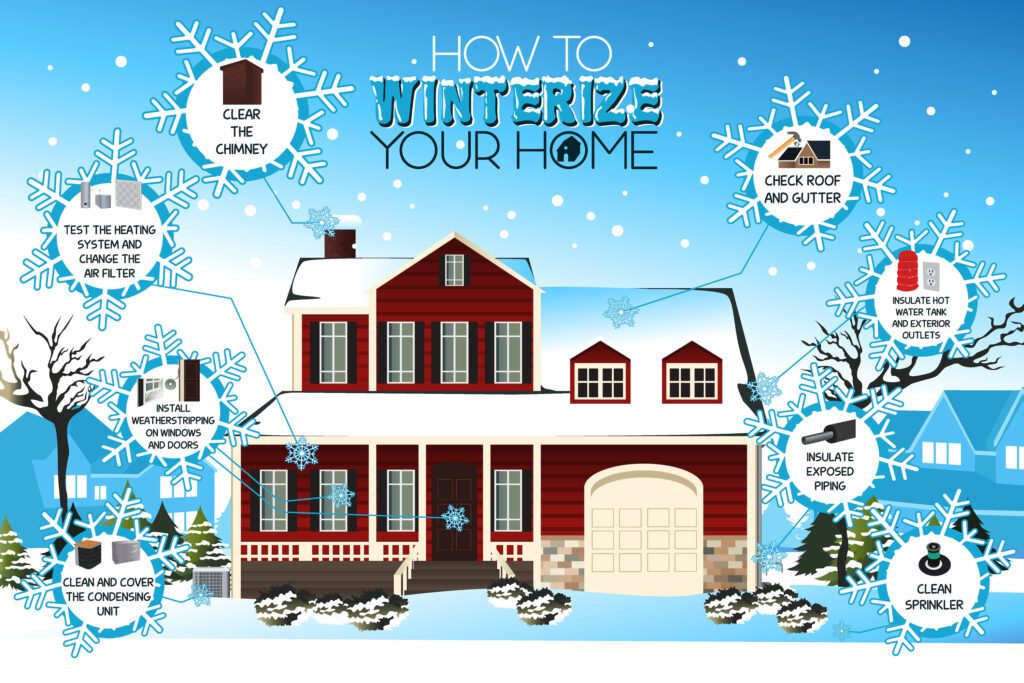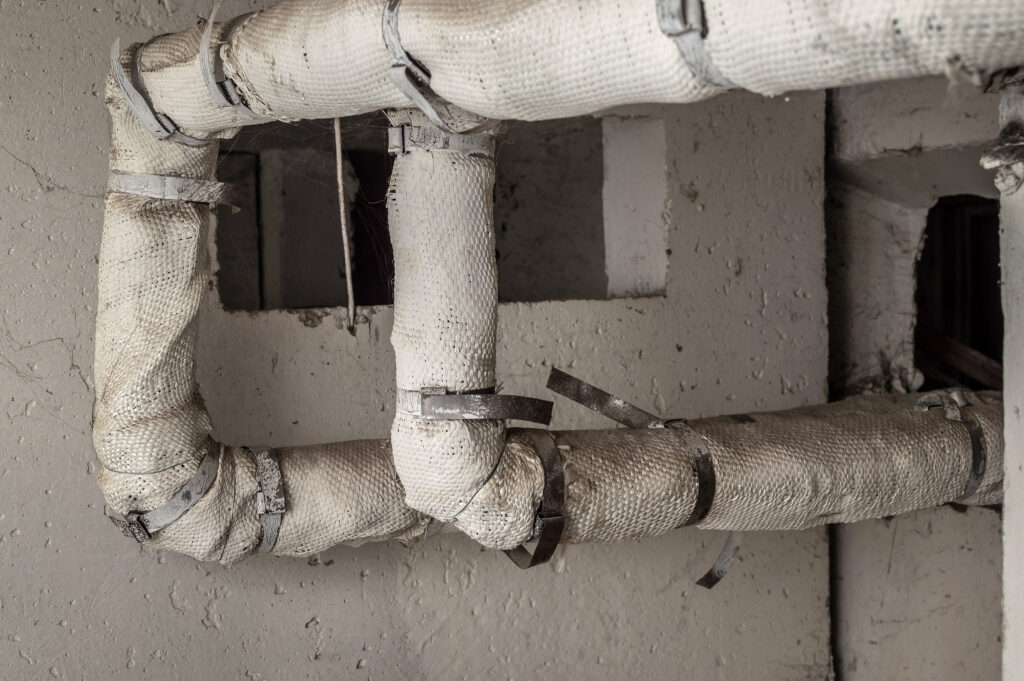
Consider the Following When Winterizing Your Home
Winterizing your home entails a series of steps and things to think about when preparing for the winter. It is important to prepare your home for winter when living in areas that drop below freezing. In this post, we will cover some of the most important steps to efficiently prepare your home when winterizing.
Insulate your home
Insulating your home is an important step in maintaining a comfortable living environment and reducing your energy bills. There are several areas of your home that can benefit from insulation, including the attic, walls, and windows. Here are some tips for insulating these areas of your home:
Attic: The attic is a key area to insulate because it can be a major source of heat loss in the winter and heat gain in the summer. To insulate the attic, you can add insulation to the floor or the ceiling, depending on the type of insulation you choose. Some options include fiberglass batts, blown-in cellulose, and spray foam. It’s important to follow the manufacturer’s instructions and wear protective gear when installing insulation.
Walls: Insulating the walls of your home can help reduce heat loss in the winter and heat gain in the summer. There are several ways to insulate walls, including adding insulation to the interior or exterior of the wall, using insulated panel systems, or installing insulation during construction.
Windows: Insulating windows can help to reduce heat loss in the winter and heat gain in the summer, improving the energy efficiency of your home and potentially reducing your energy bills. Here are some steps you can follow to insulate your windows:
Install weatherstripping: Weatherstripping is a material that seals the gap between the window frame and the window sash or door. Apply adhesive weatherstripping or nail-on weatherstripping to seal gaps around the edges of the window frame.
Window film: This is a thin plastic film that you can apply to your windows to add an extra layer of insulation. Window film is easy to install and can be removed without damaging the window.
Insulated window treatments: These are special window treatments, such as drapes or blinds, that are designed to add an extra layer of insulation to your windows. They can be especially effective at blocking drafts and keeping heat in during the winter.
Storm windows: Storm windows are an additional layer of protection for your windows that can be installed over your existing windows. They are made of a strong, durable material that helps to keep out drafts and cold air.
Low-emissivity (Low-E) windows: These are windows that have a special coating on the glass that helps to reflect heat back into your home. Low-E windows can be more expensive than other options, but they are also very effective at reducing heat loss through your windows.
No matter which method you choose, it’s important to properly seal and insulate your windows to help reduce energy loss and save money on your energy bills. For best results, it may be worth consulting with a professional to determine the best insulation solution for your specific needs and budget.

Protect pipes
Winter can be tough on pipes, as freezing temperatures can cause them to burst and cause serious damage to your home. Here are some tips for protecting your pipes during the winter and what you need to do when winterizing the pipes:
Insulate your pipes: Wrapping your pipes with insulation can help keep them warm and prevent them from freezing. You can use foam pipe insulation or heating tape to insulate your pipes.
Disconnect your garden hoses: Make sure to disconnect your garden hoses from outdoor faucets before the winter arrives. This will help prevent water from freezing inside the hose and causing the faucet to burst.
Keep your garage doors closed: If you have pipes running through your garage, make sure to keep the doors closed during the winter. This will help keep the cold air out and the warm air in, which can help prevent your pipes from freezing.
Open your cabinet doors: If you have pipes running through your kitchen or bathroom cabinets, make sure to open the doors during cold spells. This will allow warm air to circulate around the pipes and help prevent them from freezing.
When winterizing, keep your thermostat set to the same temperature: Don’t let the temperature in your home drop too low when you’re away or sleeping. This can cause your pipes to freeze and potentially burst.
Maintenance
Now that you have got your pipes covered and secured for the winter chill, its time to consider maintenance for your furnace chimney and roof. Here are a few maintenance tips to help ensure that these systems are prepared for the colder months:
Furnace: It’s a good idea to have your furnace inspected and serviced by a professional before the winter season. This can help identify any potential issues and prevent breakdowns during the colder months. It’s also important to change the air filter regularly and keep the area around the furnace clear of any debris.
Chimney: If you use a fireplace or wood stove, it’s important to have your chimney inspected and cleaned annually. A chimney sweep can remove any blockages, such as creosote or bird nests, that can cause a fire hazard. It’s also a good idea to check the chimney cap and make sure it’s in good condition to prevent animals from entering the chimney.
Roof: Winter weather can be harsh on your roof, so it’s important to make sure it’s in good condition before the cold weather arrives. Check for any missing or damaged shingles, and make repairs as needed. It’s also a good idea to remove any leaves or debris from the gutters to prevent ice dams from forming. This is an important and often overlooked step during the winterizing process.
By taking the time to properly maintain your furnace, chimney, and roof, you can help ensure that your home stays warm and safe throughout the winter season. But speaking of keeping things safe here are a few other important details to consider when preparing for the winter months.
Emergency preparedness and Winterizing
Don’t forget that winterizing your home doesn’t mean just wrapping pipes and covering windows. There is a lot more to it such as emergency preparedness is an important aspect of keeping your home and family safe, especially during the winter months. Here are a few key things to consider when preparing for emergencies:
Storm kit: It’s a good idea to have a storm kit on hand in case of power outages or other emergencies. This kit should include essential items such as non-perishable food, water, flashlights, batteries, and a first aid kit.
Alternative heating sources: If you lose power, it’s important to have a backup plan for staying warm. Consider purchasing a portable heater or having extra blankets and warm clothing on hand. It’s also a good idea to have a fireplace or wood stove as an alternative source of heat.
Carbon monoxide detectors: Carbon monoxide is a colorless, odorless gas that can be deadly if inhaled. It’s important to have carbon monoxide detectors installed in your home, particularly if you have a gas furnace or use a fireplace. These detectors will alert you if there are dangerous levels of carbon monoxide present in your home.
By taking the time to prepare for emergencies, you can protect not only your home but also you and your family.
Keep Spaces Clean in Your Home
Junk removal is also an important task that can help you keep your home clean, organized, and energy efficient during the colder months. Here’s how you can tackle this task effectively:
Start by going through each room in your home and decluttering. This can help you identify items that you no longer need or use, and give you an opportunity to donate, sell, or dispose of them. Consider hiring a junk removal service such as Pine State Hauling and Junk Removal, based out of Portland and covering all of Southern and Mid Coast Maine, to haul away large items or a dumpster to dispose of smaller items.
In conclusion, winterizing your home is an important step to take in order to prepare for the colder months and ensure that your home is energy efficient, comfortable, and safe. By insulating your attic, walls, and windows, protecting your pipes, sealing up drafts, and preparing your heating system, you can save money on energy bills, improve indoor air quality, and protect your home against damage caused by extreme weather conditions. While some of these tasks may require professional assistance, there are also many things you can do yourself to winterize your home. By taking the time to prepare your home for the winter, you can enjoy a warm and comfortable living environment all season long.
You can also read this article on Medium here

